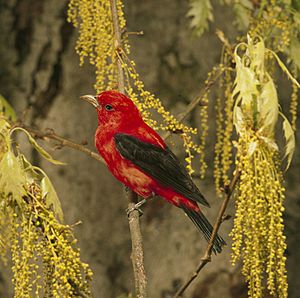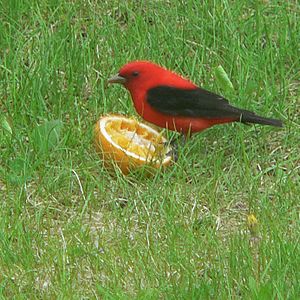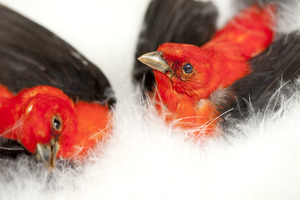Scarlet tanager facts for kids
Quick facts for kids Scarlet tanager |
|
|---|---|
 |
|
| Adult male | |
| Conservation status | |
| Scientific classification | |
| Kingdom: | |
| Class: | |
| Order: | |
| Suborder: | |
| Infraorder: | |
| Family: | |
| Genus: |
Piranga
|
| Binomial name | |
| Piranga olivacea |
|
The scarlet tanager (Piranga olivacea) is a medium-sized American songbird. It's known for its bright colors, especially the males. These birds are now part of the cardinal family, even though they used to be grouped with other tanagers. Birds in the same "family" share many similar features.
Contents
What Does a Scarlet Tanager Look Like?
The scarlet tanager is a mid-sized passerine bird, which means it's a type of songbird. It's the smallest of the four Piranga species that live north of Mexico. These birds usually weigh about 25 to 35 grams (about 1 ounce). They are about 16 to 19 centimeters (6 to 7.5 inches) long. Their wingspan can be from 25 to 30 centimeters (10 to 12 inches).
Male and Female Colors
Adult scarlet tanagers have pale, horn-colored beaks.
- Males: Adult males are a striking crimson-red color. They have black wings and a black tail. This bright red is even deeper than the red of a northern cardinal. Unlike cardinals, scarlet tanagers have black wings, which makes them easy to spot.
- Females: Females are mostly yellowish underneath and olive-green on top. Their wings and tail are also yellow-olive.
- Winter Males: In winter, adult males change their feathers. They look similar to females, but their wings and tail stay darker. Young males have a mix of colors, looking like a blend of adult males and females.
How to Tell Them Apart
It can be tricky to tell female, young, and non-breeding male scarlet tanagers apart from other similar birds.
- Summer Tanagers: These birds are more brownish overall.
- Western Tanagers: These birds always have clear white bars on their wings. They also have more yellowish undersides than scarlet tanagers.
Sounds of the Scarlet Tanager
The song of the scarlet tanager sounds a bit like a rougher version of the American robin's song. It's also similar to the songs of the summer and western tanagers. However, their call is very unique. It sounds like a distinct chip-burr or chip-churr. This is different from the pit-i-tuck call of the summer tanager and the softer pri-tic of the western tanager.
Where Do Scarlet Tanagers Live?
Scarlet tanagers like to breed in large areas of deciduous forests. These are forests where trees lose their leaves in autumn. They especially like forests with oak trees. They need at least 10 to 12 hectares (about 25 to 30 acres) of forest to have a good breeding population.
Migration Journey
In winter, scarlet tanagers fly south to the mountain forests in the Andes foothills of South America. They travel through Central America. They usually arrive in their breeding grounds in North America around May. By mid-summer, they start their journey south again. By early October, most of them are already on their way to South America.
What Do Scarlet Tanagers Eat?
Scarlet tanagers spend a lot of time high up in trees looking for food. They often fly out to catch insects in the air, a hunting style called "sallying." They might also find their prey on the forest floor.
Insect Diet
Their main food is insects. They will eat almost any flying insect that is common, such as:
- Bees, wasps, hornets, and ants
- Moths and butterflies
- Beetles and flies
- Cicadas, leafhoppers, and plant lice
- Termites, grasshoppers, and locusts
- dragonflies
They also eat snails, earthworms, and spiders. When they catch stinging insects like bees or wasps, they rub them against a branch. This helps them remove the stingers before eating.
Fruit and Berries
When there aren't many insects around, scarlet tanagers will eat fruit. They enjoy a wide variety of berries, including:

Life Cycle and Breeding
Male scarlet tanagers arrive at their breeding grounds in North America from mid-May to early June. Females usually arrive a few days to a week later.
Nests and Eggs
After they arrive, the birds quickly build nests and lay eggs, usually within two weeks. A female typically lays four eggs, but sometimes it can be three to five, or rarely, one to six eggs. The eggs are a light blue color, sometimes with a hint of green or white.
Hatching and Growth
The eggs hatch after 11 to 14 days. When they hatch, the baby birds weigh about 4 grams (0.14 ounces). By the time they are 10 days old, they weigh about 20 to 22 grams (0.7 to 0.78 ounces). This is about 70% of what their parents weigh! The young birds leave the nest when they are 9 to 12 days old. They can fly well by the time they are a few weeks old. The timing of hatching and leaving the nest depends on how far north the birds are breeding. It can be from June to early July in the south, or as late as August or September in the far north.

Images for kids
-
Female eating a flowering dogwood fruit in New York
See also
 In Spanish: Tángara rojinegra migratoria para niños
In Spanish: Tángara rojinegra migratoria para niños




